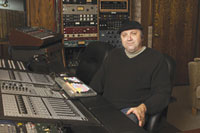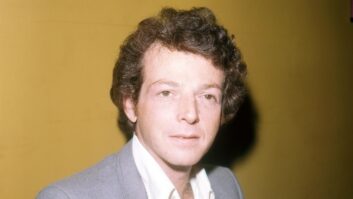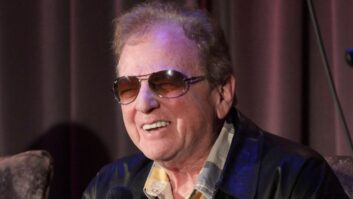
David Bianco in Dave’s Room, formerly Mama Jo’s room
Two years ago, David Bianco performed an extreme makeover on a once-great studio and brought it back to life. It was a significant act of landmark preservation, but for the Grammy-winning producer/engineer/mixer, who has a discography running from Johnny Cash to AC/DC, it was also a crucial career move.
“More and more,” Bianco says, “A&R guys would call, and tell me, ‘My artist really wants you to mix his record — you have your own place, don’t you?’ It became obvious that to keep the standards high during a time of declining budgets, it would be necessary to get my own spot. After several years of looking, I spotted a listing on Craigslist for what had been Mama Jo’s.”
Built in the late 1960s by producer/engineer Freddie Piro, the tracking room/control room facility at the northern tip of North Hollywood had drawn the likes of the Alan Parsons Project, Burt Bacharach, Smokey Robinson, Pat Benatar, Ambrosia and other big names before falling into disrepair in recent years.
“I grabbed a friend to go check out the place,” Bianco recalls. “When I pushed open the door, I saw that it was double-thick, with a resilient channel in the wall. It was a cave in here; the floor was all uneven from a water leak. We started looking around with flashlights, and I said, ‘Man, this is the real deal!’”
Bianco stands in the renovated tracking room of what is now called Dave’s Room, its walls covered in the original dark-wood paneling and period fabric. “Look at this wall,” he says, opening the double door to show its thickness. “You don’t see this in your basic Sheetrock project studios. It would cost several million to build a studio like this today.”
He took a five-year lease from the landlord, a furniture-store owner who’d bought up the whole block. “My landlord was unaware of the quality or history of the studio and intended to tear it down,” he says. “So it was serendipitous that I showed up. I did some bartering to renovate it — trading out studio time to a guitarist/flooring guy and a drummer/electrician.”
Piro’s original Trident desk was long gone, but that was a non-issue for Bianco. “I didn’t feel a need to go that route,” he says. “There was no deep-pockets investor. I was using savings to get up and running, and the expense and maintenance of a vintage console was not part of the plan. I felt deeply that, having spent much of my early engineering years constantly figuring out how to bypass electronics in consoles to find the cleanest signal path, that there was little point in having a board. After all, it’s not like we’re limited on tracks and have to combine stuff all the time. It’s not necessary in the mixing process, either. I like using great mics with my favorite preamps and equalizers, and going directly into the drive.”
We walk into the restored, Vincent van Haaff-designed control room. “That’s my console,” he says, pointing to a compact Audient Sumo, a Class-A summing mixer with a selectable G Series-style compressor and an insert point to which you can connect a different compressor, equalizer, etc. He uses it with a Digidesign Pro Control. “I like to break out of the box, and I like a fader every now and then,” he explains. “I’m old-school in that way.”
Bianco records through a Neve Suitcase with direct outs, and for additional preamps he uses a combination of old (including API and Altec) and new (Great River, SSL, Little Labs and Digidesign). “I like the Neve for the kick and snare,” he says, “but for the clarity of overheads, I like a clearer pre, so I’ll use something a little newer. I’ve got all my favorite colors here — Neve, API, Quad 8 and the modern stuff for recording — and when I mix I have the option of running it through them or not. But they’re not attached to an enormous bus matrix with lots of wires and a bunch of amps that are taking the signal and deteriorating it. It’s just the pure signal.”
Bucking the conventional wisdom has been working for Bianco in the year and a half Dave’s Room has been in operation. He’s P/E/M’d albums for Big Head Todd & The Monsters, Blues Traveler and Keaton Simons, while serving as engineer/mixer for producer George Drakoulias on soup-to-nuts projects for Paddy Casey, Tift Merritt and, most recently, Susan Tedeschi. The bookings have been filled out with a variety of mix jobs.
“One of the biggest pluses about this place,” he says, “is that the acoustics are phenomenal, with just the right amount of live to dead material to allow the natural timbre of instruments to be recorded in a very pleasing manner. It’s also the perfect amount of space for up to six musicians to record live, vibing off one another, with great sight lines and plenty of separation. I’ve been getting spirited and often magical takes that have so much more soul to them than I’d get from building the tracks, which is what people wind up doing with their home studios.”
Send L.A. news to
bs7777@aol.com.


